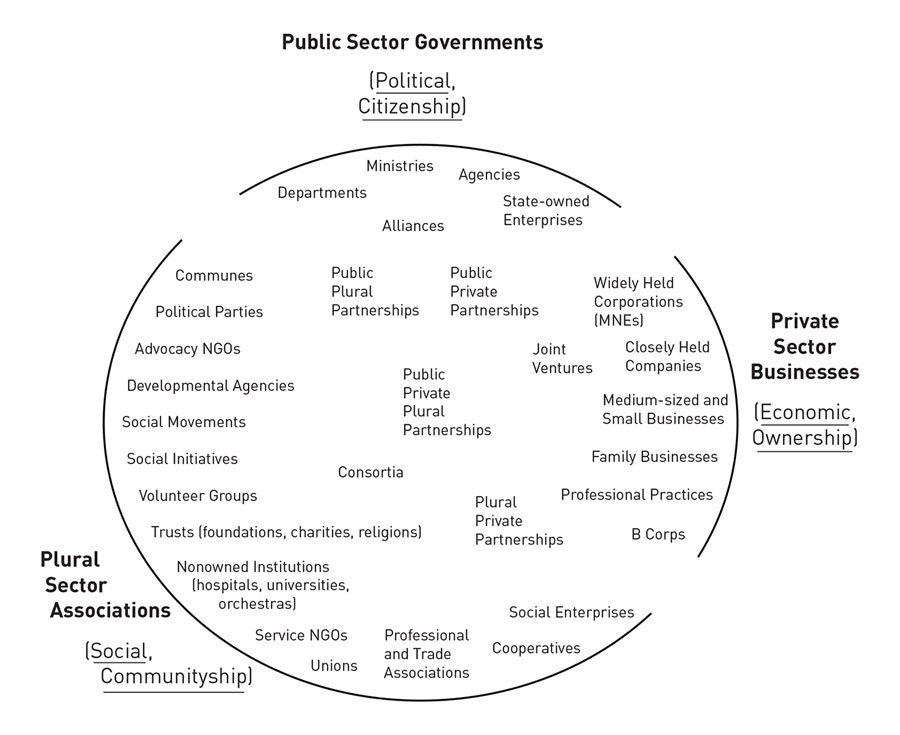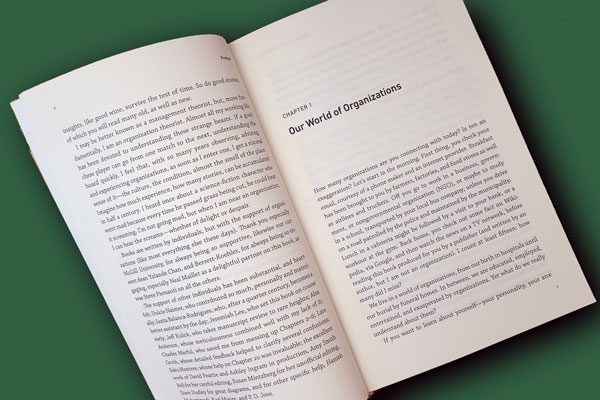Our World of Organizations
27 January 2023Excerpts from Chapter 1 of
Understanding Organizations…Finally!
How many organizations are you connecting with today? Is ten an exaggeration? Let’s start in the morning. First thing, you check your email, courtesy of a phone maker and an internet provider. Breakfast has been brought to you by farmers, factories, and food stores as well as airlines and truckers. Off you go to work in a business, government, or nongovernmental organization (NGO), or maybe to study in a school, transported by your local bus company, unless you drive on a road patrolled by the police and maintained by the municipality. Lunch in a cafeteria might be followed by a visit to your bank, or a workout at the gym. Back home, you check out some fact on Wikipedia, via Google, and then watch the news on a TV network, before reading this book produced for you by a publisher (and written by an author, but I am not an organization). I count at least fifteen: how many did I miss?
We live in a world of organizations, from our birth in hospitals until our burial by funeral homes. In between, we are educated, employed, entertained, and exasperated by organizations. Yet what do we really understand about them?
If you want to learn about yourself—your personality, your anxeties, whatever—walk into any bookstore and choose from among dozens of books on self-help. If you are concerned about the economy, read any number of political blogs to get the latest word. But between our micro selves and our macro economies, where can we go to find out how these social things called organizations really work?
Welcome to Understanding Organizations . . . Finally!
A Big Picture
Let’s start with a big picture: the immense variety of organizations out there. The figure below organizes organizations according to the sector in which they work: public sector governments, private sector businesses, and plural sector associations. You probably know something about many that are listed, but here they are altogether:
Biggest, Boldest, Smallest, Strangest
What’s the biggest organization you can think of? My choice is not quite the biggest so much as the boldest. The National Health Service of England has boasted of being surpassed in size only by the Chinese Red Army, Walmart, and the Indian Railroad. Some standards! Is this the mind-set you want from the physician who will be delivering your baby?
What’s the smallest? I discovered this early, working for a tiny tag and label company. It had two managers: one for production, the other for sales. They couldn’t figure out why the order dockets took so long to get into production, so I tracked them. A docket sat on the desk of one of the managers until he signed it, then on the desk of the other until he signed it, then back to the first. The moral of the story is that two managers are more than enough to make a bureaucracy.
What’s the strangest organization you can think of? How about the Paperweight Collectors Association, or the Association of Association Executives? Some years ago, I came across the Flying Funeral Directors of America, with the stated mission “to create and further common interest in flying and funeral services; to join together in master disaster, and to improve flying safety.” Some mission: they couldn’t decide whether to bury the passengers or save them.
And what’s the most common organization? Restaurants, perhaps: there’s probably one around the corner from you. Yet think about how even restaurants vary—from greasy spoons to fast-food franchises to gourmet dining rooms to caterers of events. We can no more find one best way to structure all these restaurants than can we find one best chef to cook in all of them.
Organization No-Speak
Two Canadian biologists meet to discuss their research. One has been studying bears, the other beavers. But let’s assume that they have no such vocabulary—no words for these different species—only the word mammal, much the way we use the word organization. They get into a discussion about where is the best place for a mammal to spend the winter.
“In a cave, of course,” says the bear biologist.
“Are you kidding?” says the beaver biologist. “Their predators will come in and eat them. They have to build a wooden structure by the side of a lake so they can swim into it safely.”
“Now you’re the one who’s kidding,” retorts the bear biologist. “Mammals don’t have predators!”
They talk past each other because of the limitations of their vocabulary, just as we talk past each other because we lack vocabulary to discuss species of organizations. Ignorance is our predator: it devours our organizations by ignoring their differences. This book provides a vocabulary to get past that.
Fives to Sevens (and Beyond)
In 1983 I published Structure in Fives, which was a shorter version of The Structuring of Organizations: A Synthesis of the Research, published in 1979.7 Recently I felt the time has come to revise it, as a synthesis of a half century of experience with organizations, especially to extend the five forms that were the basis of that book to seven, alongside seven forces that lie at the heart of structuring organizations.
As I began this book, I had a chat with Jeremiah Lee, a consultant friend in Boston who knows much of my work well. He asked a question that took this book to another place. Since a number of my other books were written as syntheses (about strategy, managerial work, and balance in society), he asked how about a synthesis of these syntheses.10 Hence I decided (a) to rename the main title Understanding Organization . . . Finally! (b) to bring together an understanding of managing, decision making, and strategy formation around the central issues of organizing; and (c) to do all this in a much more spirited tone, in an effort to reach everyone who needs to understand organizations. (How am I doing so far?)
As you might have guessed, there are seven parts in this book. After “Re-Viewing the Organization” in Part I, Part II introduces the basic building blocks of organization design, which Part III assembles into four fundamental forms of organization (Personal, Programmed, Professional, and Project).
Beyond a set of forms, we need to see organizing as a web of forces. Accordingly, Part IV introduces four basic forces (consolidation, efficiency, proficiency, and collaboration), one of which predominates in each of the four forms, and three additional forces that can be prevalent in all of the forms (the overlay of separation, the infusion of culture, and the intrusion of conflict). These three forces, in turn, suggest three more forms (Divisional Form, Community Ship, and Political Arena), which are described in Part V, thus leaving us up with seven forms and seven forces.
Part VI weaves these forces through the forms, to describe how they anchor the forms to prevent them from going out of control, establish hybrids of them, and drive transitions across the life cycle of organizations.
Part VII closes the book by opening it up, beyond sevens, by showing first, how organizations have been opening their borders, to go outward bound, and second, how the process of structuring the organization can be opened up, to design doing.
Hermits may not need to understand organizations, but the rest of us do, at least if we are to make constructive use of them. What are these beasts? How do they work? When don’t they work? How can we make them work better? The answers are important because, as soon as you put down this book, you will be facing the bears, beavers, and other beasts of our world of organizations. Help is on the way!
------------------
This new book Understanding Organizations...Finally!: Structure in Sevens can be ordered on Berrett-Koehler or on Amazon.
